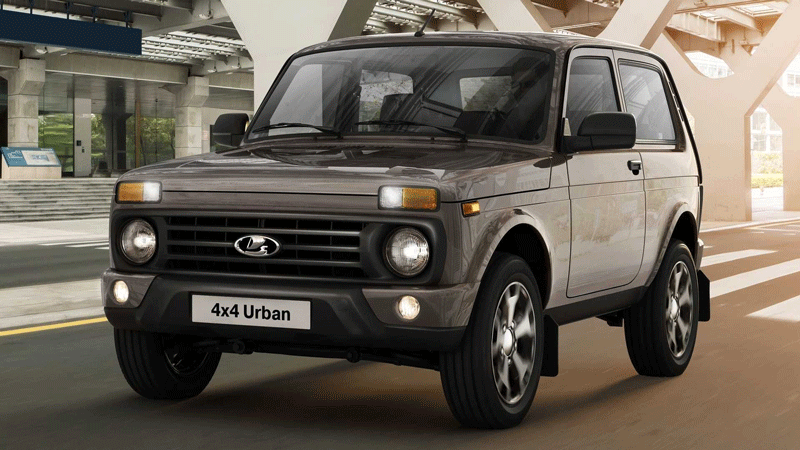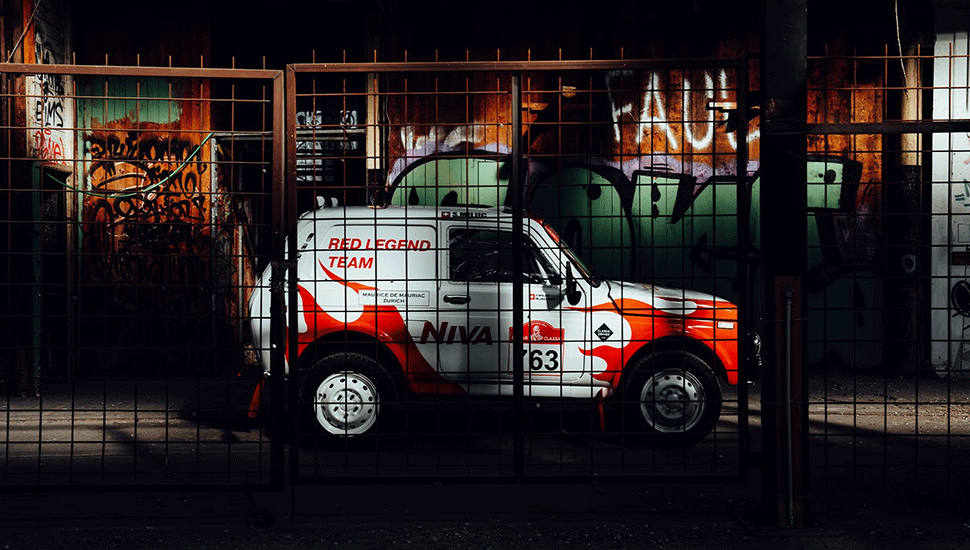Owning an off-road vehicle is like owning a symbol, because the experience it delivers goes far beyond mere transportation. The thrill begins even before you step inside, and peaks when you press the accelerator deep into the floor on those hidden trails.
Hunter UAZ: Even Legends Have Their Time
For many older Vietnamese born in the 1970s, the U-Oát (UAZ) remains etched in memory. Once a standard government vehicle that roamed every corner of Vietnam, the UAZ stood out with its signature army-green paint, simple features, and raw, powerful drive.
Its rugged, battle-hardened character defined its style. Where modern dual-cab pickups like the Ford Ranger would struggle and give up, the UAZ climbed steep slopes, powered through pothole-filled roads, and crossed rivers even when water reached the floorboards.
But even warhorses eventually need to slow down. In 2016, the UAZ Hunter—considered the peacetime version of the legendary line—was officially introduced in Vietnam. The Hunter came with no air conditioning, no seat belts, and no creature comforts. In other words, all the weaknesses that should have been improved for modern enthusiasts were kept intact. The only thing that didn’t stay the same was the price: listed at around 400 million VND, not everyone was willing to spend that much for what many saw as a “disguised farm truck.”
Jeep Wrangler Rubicon: The Name Says It All
“Wrangler” often translates as “wanderer.” But the Wrangler Rubicon? That’s the one who never backs down. Over 2,000 years ago, on the banks of the Rubicon River, Julius Caesar faced the threat of being stripped of power or assassinated. With no way back, he led his troops across the Rubicon. Even though stronger enemies awaited, that do-or-die gamble gave Caesar the chance to build his empire.
That’s why Fiat Chrysler Automobiles (FCA) chose “Rubicon” for the most capable version of the Jeep Wrangler. It’s powerful, unique, and infused with Caesar’s DNA of conquest. Outfitted with specialized equipment, the Wrangler Rubicon pushes through forests, rivers, and rocky mountains—reaching lands where few vehicles dare go. With its iconic Jeep heritage design, the Wrangler Rubicon stands as a true symbol of boundless adventure.
In Vietnam, the American dream has never lost its allure, but car enthusiasts have long grown cold toward Jeep—for one simple reason: price.
Discovery: A Legend of Distant Horizons
In Vietnam, most people who spend 4 to 6 billion VND on a car are wealthy—sometimes very wealthy. They spend five days in the city, two days in the forest, and occasionally embark on a cross-country journey to unwind. For them, the Land Rover Discovery echoes like a call from distant horizons.
The Discovery was born in the 1980s, when the British automaker had only one off-road luxury line: the Range Rover. To reach a broader audience, they needed a new, more accessible model.
The first-generation Discovery shared most of its components with the Range Rover: the signature boxy design, side-hinged rear door with spare wheel, and a manually operated sunroof above the third-row seats that gave passengers a convertible-like breeze.
Before launching the fifth-generation Discovery, Land Rover engineers tested it over 1.2 million kilometers—equivalent to circling the Earth 30 times. From scorching 50°C desert nights in Dubai to freezing -40°C winters in the Arctic, the Discovery embodied the spirit of being “Unstoppable” in all conditions

Since 1989, 2.2 million Discoveries have rolled across the planet—each telling its own story. Nearly half of them are still running strong in some of the world’s most remote places. Europe remains its main market, but its presence has grown in emerging markets like China, where the upper class is searching for unique status symbols.
Although an off-road SUV, the Discovery isn’t just for hardcore adventurers—it’s for anyone with a taste for exploration, even those who’ve never left the asphalt. Discovery invites us to step out of our comfort zone, chase new horizons, and test our own limits. True to its name, it’s not just about discovering new lands, but also new abilities, new experiences—and perhaps even a new version of ourselves!
Jimny: A Misfit Dance on Vietnam’s Dirt Roads
In the ballet of off-road driving, the Jimny moves proudly like a four-wheeled haiku, written in the language of mountains and forests. Since its debut in 1970, the Jimny has embodied simplicity and defiance—carrying the soul of a conqueror, where time and terrain blend into an epic symphony. Its sharp, boxy lines are a dialogue between modern man and untamed nature across the history of automobiles.
Each Jimny edition carries a different name, each telling the story of its spirit, its creator’s vision, and its destined landscape: Jimny SnowCat, Jimny Sierra, Jimny Ranger, Jimny Nomade, and the special Jimny Heritage edition.
Yet in Vietnam, the Jimny’s dance feels out of rhythm against the urban symphony of daily life. Today’s society demands multipurpose vehicles that can carry a family, haul groceries, and still deliver weekend fun. But the Jimny—true to its uncompromising off-road warrior spirit—remains highly specialized.
Produced in limited numbers and designed for a narrow purpose, the Jimny appeals only to artistic souls seeking occasional solitude in their imagined wilderness.
Niva Legend: A Wild Spirit in a Civilized Market
Russia has three well-known domestic car brands: UAZ for military vehicles, AURUS for ultra-luxury state cars, and LADA—the people’s car. In September 2025, Lada officially re-entered the Vietnamese market.
Dominik (Hungary): “The Niva Legend’s name translates to ‘Legend,’ but despite its proud history, its legendary value comes from the driver—not the machine. In life, when resources are scarce but wisdom is abundant, you can still achieve greatness. That’s the real legend.”
Founded in 1966 under a partnership between the Russian government and Italy’s Fiat, Lada produced affordable steel-bodied cars tough enough to survive Russian winters. Among them, the Niva became a true icon, combining traits reminiscent of the Suzuki Jimny, Jeep Wrangler, and Discovery. Look at him!

- 1971: The Volzhsky factory began designing a high-performance off-road vehicle for rural areas.
- 1972: The first prototype (E2121) was assembled, tested with various gearboxes.
- 1976: A trial batch of 50 Niva units was introduced in Moscow and tested nationwide.
- 1977: On April 5, the first commercial VAZ-2121 Niva rolled off the production line—its official birthday.
Based on the Fiat 124, the Lada 2101 was born in the 1970s. However, before it ever rolled onto the road, it was re-engineered to suit local conditions. Engineers reinforced the suspension system to handle dirt roads, strengthened the body to withstand harsh winters, and added rust protection against road salt. The engine and mechanical components were also simplified so that owners could repair the car themselves — even in remote areas without access to service centers.
On April 5, 1977, the first commercial Lada Niva, codenamed VAZ-2121, rolled off AvtoVAZ’s production line — a date now celebrated as Niva’s birthday. Unlike the Ford Model T, which famously came “in any color as long as it was black,” the early Lada came in only two colors — red and blue — reflecting the national flag and spirit of the era.
Every nation has its own automotive icon: Germany has the Volkswagen Beetle; Italy’s Fiat 500 embodies the country’s La Dolce Vita era; and Britain’s Mini Cooper captures the lively spirit of the swinging ’60s. Like those legendary cars, the Lada Niva transcended the role of mere transportation — it became a cultural foundation, a mobile ambassador representing its homeland as it spread across Europe.
After Renault-Nissan took over Lada in 2008, the alliance fully controlled it by 2012. But geopolitical turmoil in 2022 forced them to sell Lada back to the Russian government. Today, Niva Legends cost only 200–300 million VND when converted.
According to Autostat, Russia sold over 1.5 million cars in 2024 (triple Vietnam’s market), with Lada leading at 436,155 units across its four main lines: Granta, Vesta, Largus, and Niva Legend.
Key Specs of the Lada Niva Legend
- Built for urban explorers
- No screen, no airbags, no ESP
- Basic from the start—meant for heavy customization
- Three-door off-road SUV styling
- Dimensions: 3,640 x 1,680 x 1,640 mm
- Wheelbase: 2,200 mm, Ground clearance: 200 mm
- 1.7L gasoline engine, 83 hp
- 5-speed manual, 4WD
- 0–100 km/h in 19 seconds
- Fuel consumption: 10L/100km
The Niva Legend isn’t just another choice—it’s a four-wheeled “toy,” carrying the cultural DNA of Russian motoring. With an on-road price (before mods) equivalent to a Hyundai Accent or entry-level Toyota Vios, Vietnamese face a dilemma: is it worth paying for a raw off-road soul?
That’s the big question facing both Niva Legend and Suzuki Jimny in Vietnam. In a society where practicality often outweighs passion, can the Niva—with its raspy growl, old-school manual shifter, and generous fuel appetite—find a place in the hearts of new drivers and seasoned veterans alike?
Selling an officially distributed car requires networks of dealers, service, and spare parts. But for the Niva Legend, there’s an even bigger hurdle: a community. Without a strong, passionate fan base, neither the three-door nor five-door versions of the Niva—or the Jimny—will make it beyond the showroom.
Vladimir (Russia): “There’s something special about the Lada Niva Legend, first launched nearly half a century ago in 1977. On smooth roads, its steering feels imprecise and its body rolls heavily in corners. But that’s not the Niva’s path. Off-road is where this urban adventurer shines—thanks to its flexible suspension, four-wheel drive with central differential lock, and rare manual gearbox. A car for those who enjoy playing in the mud—but don’t want to live stuck in it.”
